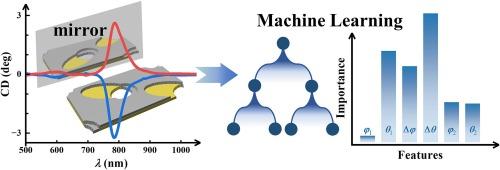利用影球光刻技术进行纳米加工的总体优化框架:手性纳米孔阵列案例研究。
IF 9.4
1区 化学
Q1 CHEMISTRY, PHYSICAL
引用次数: 0
摘要
影球光刻技术(SSL)在制造复杂纳米结构方面具有无与伦比的优势,但由于参数空间巨大,优化这些结构仍然具有挑战性。本研究针对 SSL 制造的纳米结构提出了一个通用优化框架,并通过手性超材料进行了演示。该方法结合了定制的 SSL 程序、用于消除冗余结构的新型数学模型以及有限差分时域(FDTD)模拟的机器学习(ML)分析。该框架应用于旋转纳米孔阵列(RHA),能有效地浏览 7200 个结构参数空间,识别出圆周二色性(CD)和 g 因子分别高达 3.23˚ 和 0.28 的最佳配置。对优化的 RHA 进行的实验验证表明,它们与预测结果非常吻合,手性响应是随机配置的两倍。值得注意的是,该框架将数据集减少了 86%,大大降低了计算成本。这种优化框架能更快、更系统、更高效地优化使用 SSL 制造的结构,从而有可能加速纳米光子学、等离子体学和手性传感应用的发现。本文章由计算机程序翻译,如有差异,请以英文原文为准。

A general optimization framework for nanofabrication using shadow sphere Lithography: A case study on chiral nanohole arrays
Shadow sphere lithography (SSL) offers unparalleled advantages in fabricating complex nanostructures, yet optimizing these structures remains challenging due to vast parameter spaces. This study presents a general optimization framework for SSL-fabricated nanostructures, demonstrated through chiral metamaterials. The approach combines a custom SSL program, a novel mathematical model for eliminating redundant structures, and machine learning (ML) analysis of finite-difference time-domain (FDTD) simulations. Applied to rotated nanohole arrays (RHAs), this framework efficiently navigates a 7200-structure parameter space, identifying optimal configurations with circular dichroism (CD) and g-factor up to 3.23˚ and 0.28, respectively. Experimental validation of optimized RHAs shows good agreement with predictions, exhibiting twice the chiral response of random configurations. Notably, the framework reduces the dataset by 86%, significantly decreasing computational costs. This optimization framework enables faster, more systematic, and more efficient optimization of structures manufactured using SSL, potentially accelerating discoveries in nanophotonics, plasmonics, and chiral sensing applications.
求助全文
通过发布文献求助,成功后即可免费获取论文全文。
去求助
来源期刊
CiteScore
16.10
自引率
7.10%
发文量
2568
审稿时长
2 months
期刊介绍:
The Journal of Colloid and Interface Science publishes original research findings on the fundamental principles of colloid and interface science, as well as innovative applications in various fields. The criteria for publication include impact, quality, novelty, and originality.
Emphasis:
The journal emphasizes fundamental scientific innovation within the following categories:
A.Colloidal Materials and Nanomaterials
B.Soft Colloidal and Self-Assembly Systems
C.Adsorption, Catalysis, and Electrochemistry
D.Interfacial Processes, Capillarity, and Wetting
E.Biomaterials and Nanomedicine
F.Energy Conversion and Storage, and Environmental Technologies

 求助内容:
求助内容: 应助结果提醒方式:
应助结果提醒方式:


